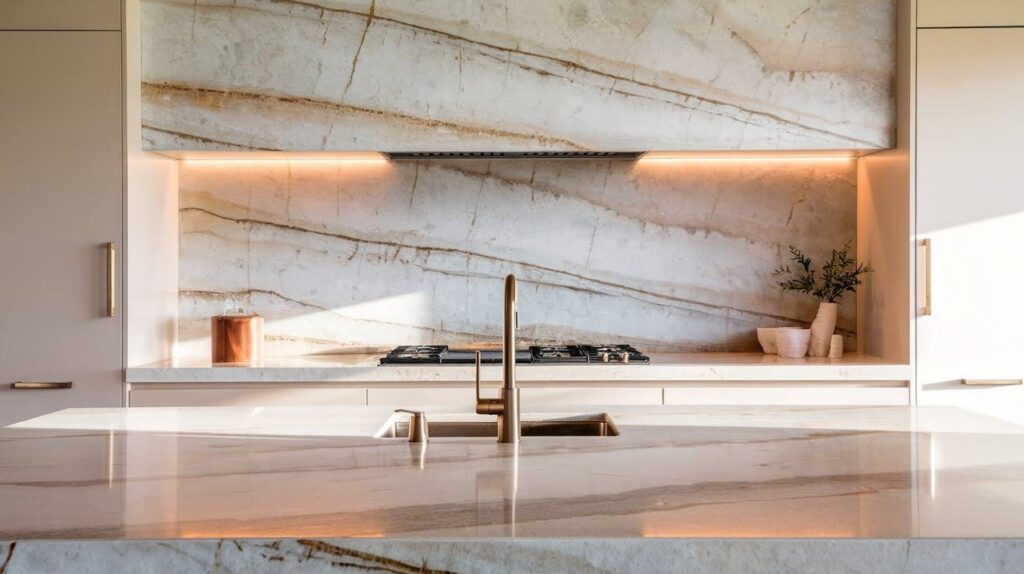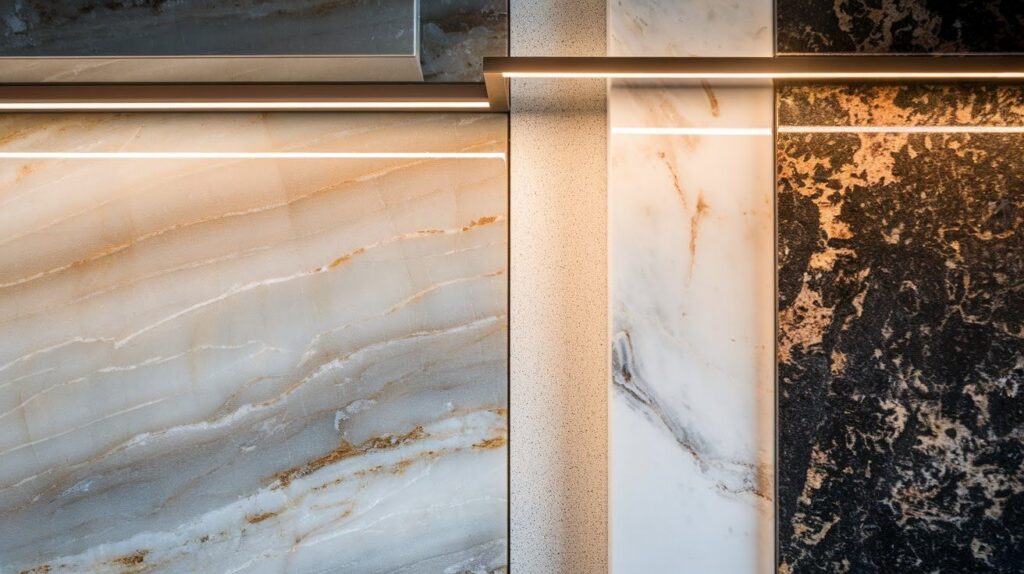Thinking about quartzite countertops for your home? I get it.
When I first learned about this natural stone, I was amazed by how it combines the look of marble with serious strength.
It’s no wonder so many homeowners are choosing quartzite for their kitchens and bathrooms.
But before you make any decisions, you need to know both sides of the story.
In this guide, I’ll share the real pros and cons of quartzite countertops. My goal is to help you figure out if this beautiful stone is the right choice for your home and lifestyle.
What Are Quartzite Countertops?

Quartzite is a natural stone formed from sandstone that offers strength, beauty, and versatility for various home applications.
How Quartzite Forms
Quartzite begins as sandstone buried deep underground.
Over millions of years, extreme heat and pressure transform it into one of the hardest natural stones available. The sand grains fuse together, creating an incredibly dense material.
Appearance and Characteristics
Quartzite features beautiful veining similar to marble. Colors range from white and gray to pink, green, and even blue or gold tones.
Each slab is unique with patterns that vary from subtle to bold. The stone has a natural shimmer that adds depth to any room.
Common Uses in Home Design
Kitchen countertops are the most popular use for quartzite. The stone also works well for bathroom vanities, flooring, and wall accents.
Some homeowners choose it for outdoor spaces like patio counters since it handles weather changes effectively.
Pros of Quartzite Countertops

Quartzite offers impressive benefits that make it a smart investment for homeowners seeking performance, style, and long-term value.
1. Exceptional Durability and Strength
Quartzite ranks high on the hardness scale, making it one of the toughest countertop materials available. It resists scratches from knives and daily kitchen tools better than many other stones.
This natural strength means your countertops will look great for decades. You won’t need to worry about chips or cracks from normal use.
2. Natural Beauty and Unique Patterns
Every quartzite slab features distinct veining and patterns found nowhere else. The natural formations create visual interest that manufactured materials simply can’t match.
These organic patterns add character to your kitchen or bathroom. The stone’s appearance brings a sense of luxury without feeling overdone.
3. Heat and UV Resistance
You can place hot pots and pans directly on quartzite without damaging the surface. The stone formed under extreme heat, so your cookware won’t harm it.
Quartzite also resists fading from sunlight. This makes it perfect for kitchens with large windows or outdoor cooking areas that get direct sun exposure.
4. Versatility in Design
Quartzite works with almost any interior style. It fits beautifully in modern kitchens with clean lines and minimalist features.
The stone also complements rustic farmhouse designs and traditional homes. Its natural quality adapts to your personal taste and existing decor.
5. Easy to Clean and Maintain (When Sealed Properly)
Daily cleaning is simple. Just wipe down the surface with water and a mild detergent. You don’t need special cleaners or complicated routines.
Proper sealing protects the stone from stains. Once sealed, maintenance becomes straightforward and hassle-free for busy households.
6. Wide Range of Natural Colors
Quartzite comes in many colors beyond basic white and gray. You’ll find options in soft pink, forest green, deep blue, and warm gold tones.
This variety lets you choose a color that matches your design vision. From neutral palettes to bold statements, there’s a quartzite option for every preference.
Cons of Quartzite Countertops

While quartzite has many advantages, it’s important to consider the potential drawbacks before making your final decision on this natural stone.
1. Higher Cost Compared to Other Stones
Quartzite typically costs between $60 to $150 per square foot, including installation.
This puts it in the premium category, costing more than granite or laminate. Budget carefully for not just the stone but also installation, sealing, and edge finishing.
2. Porosity and Need for Sealing
Quartzite is porous and can absorb liquids if left unsealed. Spills like wine, oil, or acidic juices may create permanent stains.
Proper sealing creates a protective barrier, but you’ll need to maintain it over time to keep your countertops looking great.
3. Challenging Installation
Quartzite slabs are extremely heavy and dense. They require specialized equipment and experienced professionals to install.
DIY installation is not recommended, and professional help adds to the overall expense.
4. Limited Availability and Color Range
Finding the exact shade you want can be challenging with natural stone.
Availability depends on what quarries are producing. Matching slabs for larger projects can be tricky since each piece is unique.
5. Occasional Maintenance Required
Quartzite needs resealing once or twice a year to maintain protection.
High-traffic areas may need more frequent attention. Skipping this maintenance can lead to staining and damage over time.
Quartzite vs. Other Countertop Materials

Understanding how quartzite compares to other popular countertop options helps you make an informed choice for your home and budget.
Quartzite vs. Quartz
Quartzite is a natural stone, while quartz is engineered from ground stone and resin. Quartzite handles heat better and won’t scorch from hot pans.
Quartz requires no sealing and is more stain-resistant. Quartzite needs regular sealing to maintain protection. Both fall in the premium price range with similar costs.
Quartzite vs. Granite
Both are natural stones, but quartzite is harder and more scratch-resistant. Granite offers a wider variety of colors and patterns, especially in warm tones.
Both perform well outdoors and resist UV damage. Quartzite has a slight edge in heat resistance. Price points are comparable, with quartzite often costing slightly more.
Quartzite vs. Marble
Quartzite often looks like marble with similar veining and light colors. However, quartzite is much more durable and scratch-resistant.
Marble stains easily from acidic foods like lemon juice or wine. Quartzite handles daily use with less worry. While both need sealing, marble demands more careful maintenance and frequent attention.
Maintenance and Care Tips for Quartzite Countertops
Proper care keeps your quartzite countertops looking beautiful for years. Follow these simple tips to protect your investment and maintain the stone’s natural beauty.
- Clean daily with mild soap and water: Avoid harsh chemicals, acidic cleaners, or abrasive scrubbers that can damage the sealant and dull the surface over time.
- Reseal your countertops once or twice a year: Regular sealing protects against stains and moisture absorption, keeping the stone’s protective barrier strong and effective.
- Wipe up spills immediately, especially acidic liquids: Don’t let wine, coffee, citrus juice, or oil sit on the surface, as they can penetrate unsealed areas and cause permanent staining.
- Use cutting boards and trivets consistently: While quartzite is heat and scratch-resistant, protecting the surface with boards and hot pads extends its lifespan and preserves its finish.
- Test the seal regularly by dropping water on the surface: If water beads up, your seal is good. If it soaks in within a few minutes, it’s time to reseal.
Final Thoughts
Quartzite countertops offer incredible durability, natural beauty, and heat resistance that few materials can match.
Yes, they require sealing and come at a premium price, but many homeowners find the benefits outweigh these considerations.
I recommend visiting a showroom to see quartzite slabs in person. Photos don’t capture the depth and character of this stone.
A countertop professional can also answer your specific questions about installation, maintenance, and cost for your space.
Ready to move forward? Explore quartzite countertop options and get expert remodeling advice today. Your dream kitchen might be closer than you think.
Frequently Asked Questions
Is quartzite more expensive than granite?
Quartzite typically costs slightly more than granite, ranging from $60 to $150 per square foot installed. The higher price reflects its superior hardness and durability compared to granite.
How often do I need to seal quartzite countertops?
You should seal quartzite countertops once or twice a year depending on usage. High-traffic kitchens may need more frequent sealing to maintain protection against stains and moisture.
Can quartzite countertops stain easily?
Properly sealed quartzite resists staining very well. However, if the seal wears off, the porous stone can absorb liquids like wine, oil, and acidic substances that may cause permanent marks.
Is quartzite better than quartz for kitchen countertops?
Quartzite offers better heat resistance and natural beauty, while quartz requires no sealing and offers more consistent patterns. The choice depends on your priorities for maintenance, appearance, and budget.
Can I install quartzite countertops myself?
DIY installation is not recommended due to the stone’s extreme weight and density. Professional installation ensures proper handling, cutting, and secure placement that prevents costly mistakes.

